Related Research Articles
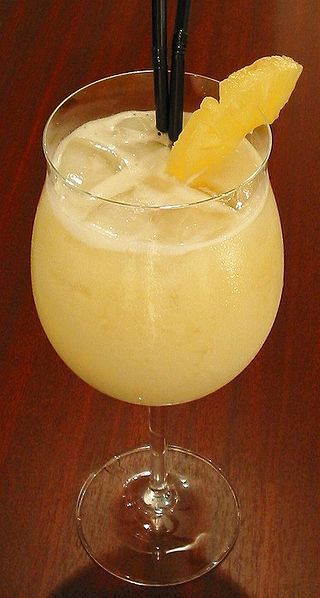
The piña colada is a cocktail made with rum, cream of coconut or coconut milk, and pineapple juice, usually served either blended or shaken with ice. It may be garnished with either a pineapple wedge, maraschino cherry, or both. The drink appears to have originated in Puerto Rico.
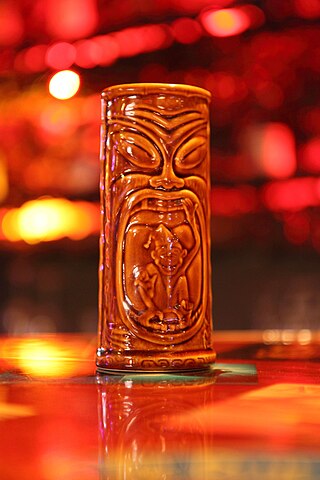
Tiki culture is an American-originated art, music, and entertainment movement inspired by Polynesian, Melanesian and Micronesian cultures. Inspired by Oceanian art, influential cultures to Tiki culture include Australasia, Melanesia, Micronesia, Polynesia, the Caribbean Islands, and Hawaii. The name comes from Tiki, the Māori name for the first human, often represented in the form of hei-tiki, a pendant and important taonga. The hei-tiki was often appropriated by Europeans as a commercialised good luck charm, hence the name of Tiki culture. Despite spanning over 10,000 miles and including many different unrelated cultures, religions, and languages, Tiki aesthetic is considered by some to be amalgamated into one "fantasia of trans-Pacific cultures" and "colonial nostalgia". Because of this, and the simplistic view of the Pacific taken by the aesthetic, Tiki culture has often proved controversial.

The Mai Tai is a cocktail made of rum, Curaçao liqueur, orgeat syrup, and lime juice. It is one of the characteristic cocktails in Tiki culture.

The Zombie is a Tiki cocktail made of fruit juices, liqueurs, and various rums. It first appeared in late 1934, invented by Donn Beach at his Hollywood Don the Beachcomber restaurant. It was popularized on the East coast soon afterwards at the 1939 New York World's Fair.

Tiki mugs are large ceramic cocktail drinking vessels that originated in tiki bars and tropical-themed restaurants. The term "tiki mug" is a blanket term for the sculptural drinkware even though they vary in size and most do not contain handles. They typically depict Polynesian, mock-Polynesian, tropical, nautical, or retro themes, and as the term is used generically do not always emulate a tiki. When used to serve drinks they are frequently garnished with fruit or decorative drink umbrellas and swizzle sticks.
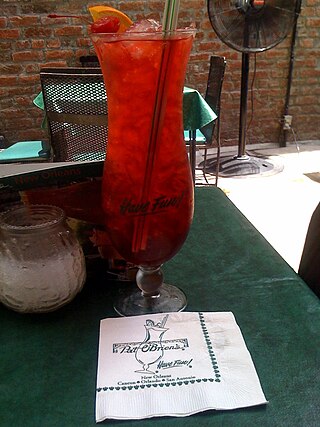
The hurricane cocktail is a sweet alcoholic drink made with rum, lemon juice, and either passion fruit syrup or fassionola. It is one of many popular drinks served in New Orleans. It is traditionally served in the tall, curvy eponymous hurricane glass. Disposable plastic cups are also used because New Orleans laws permit drinking in public and leaving a bar with a drink, but prohibit public drinking from glass containers.

A tiki bar is a themed drinking establishment that serves elaborate cocktails, especially rum-based mixed drinks such as the Mai Tai and Zombie cocktails. Tiki bars are aesthetically defined by their tiki culture décor which is based upon a romanticized conception of tropical cultures, most commonly Polynesian. Some bars also incorporate general nautical themes or retro elements from the early atomic age.
A Scorpion Bowl is a communally shared alcoholic tiki drink served in a large ceramic bowl traditionally decorated with wahine or hula-girl island scenes and meant to be drunk through long straws. Bowl shapes and decorations can vary considerably. Starting off as a single-serve drink known as the Scorpion cocktail, its immense popularity as a bowl drink in tiki culture is attributed to Trader Vic.

A flaming drink is a cocktail or other mixed drink that contains flammable, high-proof alcohol, which is ignited before consumption. The alcohol may be an integral part of the drink, or it may be floated as a thin layer across the top of the drink. The flames are mostly for dramatic flair. However, in combination with certain ingredients, the flavor of the drink is altered. Some flavors are enhanced, and the process may impart a toasted flavor to some drinks.
A carajillo is a hot coffee drink to which a hard liquor is added. It is typical of Spain and several Latin American countries, such as Colombia, where it is usually made with brandy, Cuba, where it is usually made with rum, and some areas of Mexico, mezcal or a coffee liqueur such as Kahlúa or Tía María. Carajillo is usually served in a small glass.
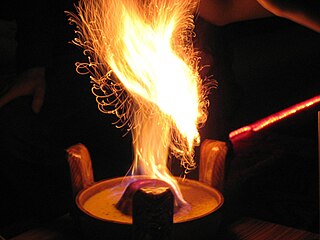
Flaming volcano is a large tropical group cocktail typically made with rum, brandy, pineapple juice, orange juice, and orgeat syrup. Many variations exist, and the cocktail in the 21st century is more about the presentation than an adherence to a set list of ingredients. It is usually a multi-user drink, served to a group in a special vessel known as a volcano bowl, which is a decorative ceramic bowl designed with a rising central hub feature resembling a volcanic cone. The cone includes a "crater" reservoir which can be partially filled with rum or another flammable liquor. The crater liquor is carefully ignited when serving, creating a mild volcanic ambiance with its central blue flame.

Hot buttered rum is a mixed drink containing rum, butter, hot water or cider, a sweetener, and various spices. It is especially popular in the fall and winter and is traditionally associated with the holiday season. In the United States, the drink has a lengthy history that dates back to colonial days. During that time many families had their own individual recipes, and early Americans believed rum to be nutritious and a strengthener of the body.
Blow my skull is an alcoholic punch drink that originated in mid-19th century Australia. As listed in The English and Australian Cookery Book by Edward Abbott, it calls for two pints of boiling water, sugar loaf, lime or lemon juice, one pint of ale or porter, one pint rum, and a half a pint of brandy. It has been described as a "notoriously potent alcoholic concoction".

The suffering bastard is the name for two different mixed drinks, one being more of a standard cocktail associated with World War II and the other being more of an exotic drink associated with Tiki bars. As is the case with many cocktails, there are multiple recipe variations and historical origins have been argued and changed over time. Two of the earliest recipe versions have very different ingredients. One from bartender Joe Scialom (1942) calls for brandy and gin, while another from Tiki pioneer Victor J. Bergeron primarily uses rum along with "secret ingredients" and is known for being garnished with a cucumber.
The test pilot cocktail is a vintage tiki drink invented by Donn Beach. Beach was known for changing his recipes over time, and multiple versions of the test pilot attributed to both him and others make the cocktail one of his more frequently imitated and varied tiki drinks. Test pilot recipes call for multiple rums and typically include the use of falernum syrup and lime juice. The more popular also include Pernod (pastis/absinthe) and bitters.
The cobra's fang is a vintage tiki cocktail invented by Donn Beach that calls for a mixture of rums along with fassionola and falernum syrups, the juice of orange and limes, and a dash each of bitters and grenadine. The recipe from the book Hawai'i: Tropical Rum Drinks & Cuisine By Don the Beaschcomber calls for it being garnished with fresh mint and a lime wheel, although a length of spiral cut lime peel made to look like a snake is used for aesthetics in some cobra named cocktails.
The Fog Cutter is a vintage tiki cocktail frequently attributed to being invented by Victor Bergeron that calls for a mixture of several liquors, the juice of lemon and oranges, orgeat syrup, and cream sherry. It is high in alcoholic content and has been called the "Long Island Iced Tea of exotic drinks." It has historically been served in special Fog Cutter ceramic mugs.
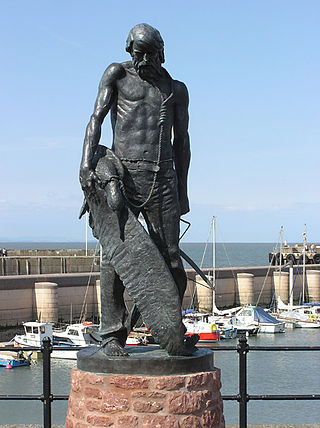
The Ancient Mariner is a tiki drink created by Jeff "Beachbum" Berry and Annene Kaye. It first appeared in their 1998 drink guide Beachbum Berry's Grog Log and is named after Coleridge's 1798 The Rime of the Ancient Mariner because in Berry's words "by the time we finished with it, that's how old we felt."
References
- ↑ "Bali Hai restaurant San Diego". critiki.com. Retrieved 22 February 2019.
- ↑ Berry, Jeff (2001). Beachbum Berry Remixed. San Jose, CA: Slave Labor Graphics. p. 142.
- ↑ "Mr. Bali Hai". cocktailvirgin.blogspot.com. Retrieved 22 February 2019.
- ↑ "Bali Hai Mug". jennbennett.net. Retrieved 22 February 2019.
- ↑ Vic, Trader (1972). Bartender's Guide, revised . Garden City, NY: Doubleday (publisher). p. 300.
- ↑ Kirsten, Sven (2000). Book of Tiki. Koln: Taschen. p. 131.
- ↑ "Bali Hai restaurant at 64". lajollalight.com. Retrieved 22 February 2019.
- ↑ "San Diego Tiki Tour" (PDF). sohosandiego.org. Retrieved 5 March 2019.
- ↑ "History". balihairestaurant.com. Retrieved 22 February 2019.
- ↑ "History". balihairestaurant.com/history. Retrieved 22 February 2019.
- ↑ "San Diego's Bali Hai". savingplaces.org. Retrieved 22 February 2019.
- ↑ "The Restoration of Mr. Bali Hai". miehana.blogspot.com. Retrieved 22 February 2019.
- ↑ "Golden Age drinks". forbiddenislandalameda.com. Retrieved 22 February 2019.
- ↑ "Bali Hai". threedotsandadash.blogspot.com. Retrieved 22 February 2019.
- ↑ "Recreating the Mai-Kai's Bizarre Black Magic Cocktail". punchdrink.com. Retrieved 22 February 2019.
- ↑ "Mr. Bali Hai". recipe.awesomedrinks.com. Retrieved 22 February 2019.
- ↑ "Tiki Drink - Mr. Bali Hai". killingtime.com. Retrieved 22 February 2019.
- ↑ "Three great tiki drinks". moderntikilounge.com. Retrieved 22 February 2019.
- ↑ "7 Most Visually Stunning Tiki Drinks in San Diego". www.zagat.com. Retrieved 22 February 2019.
- ↑ "Mr. Bali Hai". makeitperfectly.com. Retrieved 22 February 2019.
- ↑ "Mr. Bali Hai". wiki.webtender.com. Retrieved 22 February 2019.